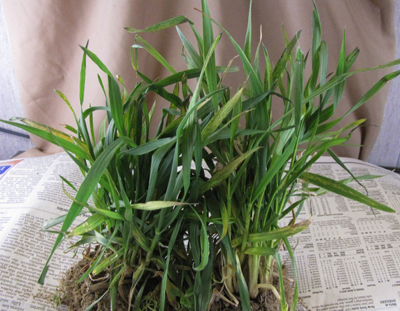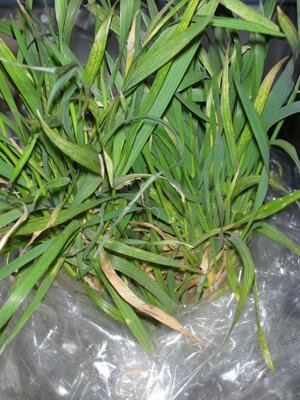USDA-NIFA Extension IPM Grant
Pest & Crop Newsletter, Entomology Extension, Purdue University
Aphids In Wheat - (Christian Krupke and John Obermeyer)
• Aphids are active very early in the spring.
• Virus transmission by aphids occurs mainly in the fall – not now.
• Watch for aphids accumulating on wheat heads late in spring.
The presence of aphids in wheat is common every spring. Unless populations are very heavy, aphid feeding contributes very little to yield losses at this time of year. In addition, aphids at this time aren’t likely to infect and spread Barley Yellow Dwarf Virus (BYDV), see related article, “Wheat Virus Diseases Prevalent in Indiana Fields,” in this issue. Plants infested with aphids in the fall are more likely to be infected with BYDV and possibly severely damaged. Insecticide applications applied after wheat reaches Feekes growth stage 4.0 does little good to prevent the transmission of BYD. In short, there is little justification to treat aphids at this time.
This is not the end of the story though - aphid populations may increase as wheat heads begin to emerge and fill. The aphids can injure developing heads by sucking plant juices. An average of 50 or more aphids per head indicates that an insecticide treatment should be considered. Normally when aphid numbers build to 10 or more per plant, aphid predators and parasites increase rapidly in response to this food source. Lady beetles (adults and larvae), syrphid (often called hover flies) larvae, lacewing larvae, and several species of parasites will soon be scouring fields for aphids. In Indiana, because of a reduced virus threat and the natural enemies, the necessity to treat for aphids in the spring is rare.
English grain aphids, live-birth
Lady beetle feeding on aphid
![]()
Click here to see the Black Cutworm Adult Pheromone Trap Report
![]()
Wheat Virus Diseases Prevalent in Indiana Fields - (Kiersten Wise and Gail Ruhl) -
In recent weeks, there have been concerns about patchy yellowing and stunted areas of wheat across fields in Indiana. Although scouting reports note symptoms on plants in fields that are suggestive of wheat spindle streak (or yellow) mosaic virus (WSSMV), soil-borne wheat mosaic virus (SBWMV), and barley yellow dwarf virus, only WSSMV has been confirmed in plant samples submitted to and tested by the Purdue Plant and Pest Diagnostic Lab (PPDL).
Virus diseases of wheat are difficult to tell apart in the field and require lab testing for accurate diagnosis. Infected plants typically first appear in uneven patches of yellow or light green within a field, which can be confused with nitrogen deficiency or winter injury. Often, symptoms appear first in low or poorly-drained areas of the field. With soil-borne mosaic viruses (WSSMV and SBWMV), yellow-green streaks may be present on leaves and stunting and/or dieback of leaf tips can occur in infected plants (Figures 1, 2, and 3). The level of symptom expression can depend on variety susceptibility. Soilborne wheat mosaic virus can cause a rosette symptom in susceptible varieties, which results in excessive production of severely stunted tillers. We have also observed reddish coloring on lower leaves of wheat plants infected with soilborne viruses (Figure 4). Plants infected with either virus may produce fewer stems and heads, and have reduced kernel number.
Figure 1. Wheat exhibiting symptoms of soilborne virus diseases (WSSMV; SBWMV)
Figure 2. Yellow “spindles” on leaves characteristic of soilborne virus disease (WSSMV).
Figure 3. Yellow streaks and mosaic on leaves caused by soilborne viruses (WSSMV; WSBMV)
Figure 4. Plants infected with soilborne viruses (WSSMV; SBWMV) may develop reddish-purple coloring on lower leaves.
Soilborne wheat mosaic and wheat spindle streak mosaic virus infect wheat plants in the fall. Both viruses are transmitted to wheat roots by the soil-borne fungus Polymyxa graminis. This fungus does not cause damage to wheat by itself, but it infects wheat roots and transmits the viruses to wheat plants. Symptoms of virus infection are not apparent until spring, and the severity of symptom expression depends on variety susceptibility and weather. Prolonged cool temperatures in spring (under 60°F) enhance symptom development of both diseases in infected fields. Often, warmer temperatures in spring will help reduce the appearance of symptoms and plants will appear to recover. Yield may not be reduced if the symptoms and distribution of virus within a field are limited, but severe and/or widespread infections can cause stunting and yield loss. Fields that are severely affected at this point in time may need to be replanted. Consult Extension specialists to determine if replanting is needed in a particular location.
Although no control methods are available to reduce symptoms in currently infected plants, it is still important to get an accurate diagnosis for management of future wheat plantings. Crop rotation may not prevent infection since the fungus that transmits the virus can survive in the soil for over 5 years. Therefore, the best way to manage these diseases is to plant resistant varieties in areas with a previous history of the diseases. Varieties are available with good resistance to one or both of the mosaic virus diseases. Be sure to check the variety if you have problems with both soilborne virus diseases in a single field, since some varieties are resistant to only one virus.
The PPDL provides testing for the presence of WSSMV, SBWMV, Wheat streak mosaic virus (WSMV) and 5 strains of Barley yellow dwarf virus (BYDV) with a multiplex PCR detection assay. Contact the PPDL (<http://www.ppdl.purdue.edu/ppdl/samples.html>) for testing fees. For an accurate diagnosis it is important to dig and submit entire plants exhibiting symptoms (see submission information at <http://www.ppdl.purdue.edu/ppdl/samples.html>).







